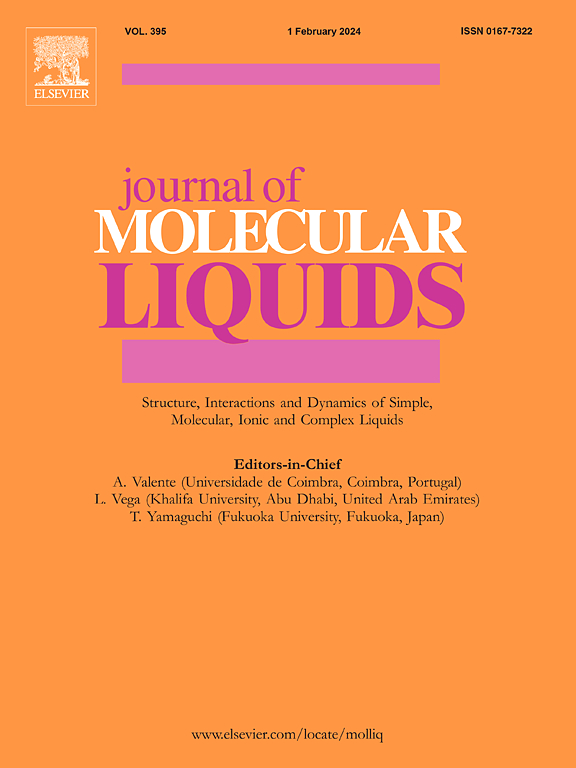IF 5.3
2区 化学
Q2 CHEMISTRY, PHYSICAL
引用次数: 0
摘要
魔芋葡甘露聚糖(KGM)胶体等天然多糖胶体因其优异的吸水性、保水性和增稠性而备受关注。然而,由于生物大分子团簇在剪切流场中的复杂动态行为难以在实验中观察到,而且各种参数对流变性能的耦合效应错综复杂,因此研究多糖胶体的流变机理仍然具有挑战性。本研究结合分子动力学模拟和布朗动力学模拟进行了多尺度模拟,揭示了 KGM 团簇和单分子链的动力学结构。粘度和存储模量的实验结果与数值结果的比较验证了多尺度模拟在分析大型 KGM 簇(∼500 nm)长时间(∼2 ms)的动力学行为方面的有效性。数值粘度与参数之间的关系与实验结果一致。KGM团簇的珠子弹簧模型的总弹簧力是胶体储存模量的适当数值指标。排除体积力的结果表明,KGM 段之间的相互作用是胶体粘度的重要来源。在实验和模拟综合数据集的基础上,使用集成机器学习模型预测胶体粘度并分析各因素的重要性。结果表明,极端梯度提升(XGBoost)模型的预测性能最佳,R2 值为 0.90。本研究通过实验研究了KGM胶体的流变特性,通过多尺度模拟研究了KGM团簇和单个分子链的动力学行为,并集成了机器学习模型预测胶体粘度和分析影响KGM胶体粘度的主要因素。它有助于加深对多糖胶体流变学机理的理解,丰富多糖溶胶体系的研究方法。本文章由计算机程序翻译,如有差异,请以英文原文为准。

Machine learning analysis for the rheological mechanism of polysaccharide colloids
Natural polysaccharide colloids such as konjac glucomannan (KGM) colloids have attracted a lot of attention due to their exceptional water absorption, water retention, and thickening properties. However, investigating the rheological mechanism of polysaccharide colloids remains challenging due to the complex dynamic behaviors of bio-macromolecular clusters in shear flow fields, which are difficult to observe experimentally, and the intricate coupling effects of various parameters on rheological performance. In this study, multi-scale simulations combining molecular dynamics simulation and Brownian dynamics simulations revealed the dynamical structures of KGM clusters and single molecule chains. The comparison between experimental and numerical results of viscosity and storage modulus validated the effectiveness of the multi-scale simulation in analyzing the dynamical behavior of large KGM clusters (∼500 nm) over a long time (∼2 ms). The relationships between numerical viscosity and parameters aligned with the experimental results. The total spring force of the bead-spring models of KGM clusters was an appropriate numerical indicator of the colloid storage modulus. The results of the exclusion of volume forces indicated that the interaction between KGM segments was an important origin of colloid viscosity. Based on the comprehensive dataset from experiments and simulations, integrated machine learning models were used to predict colloid viscosity and analyze the importance of factors. The results indicated that the extreme gradient boosting (XGBoost) model exhibited the best predictive performance with an R2 value of 0.90. This study provides the rheological properties of KGM colloids by experiments, the dynamical behaviors of KGM clusters and individual molecular chains via multi-scale simulations, and integrated machine learning models for predicting colloidal viscosity and analyzing the main factors influencing KGM colloid viscosity. It contributes to a deeper understanding of the rheological mechanisms of polysaccharide colloids and enriches the research methods for polysaccharide sol systems.
求助全文
通过发布文献求助,成功后即可免费获取论文全文。
去求助
来源期刊

Journal of Molecular Liquids
化学-物理:原子、分子和化学物理
CiteScore
10.30
自引率
16.70%
发文量
2597
审稿时长
78 days
期刊介绍:
The journal includes papers in the following areas:
– Simple organic liquids and mixtures
– Ionic liquids
– Surfactant solutions (including micelles and vesicles) and liquid interfaces
– Colloidal solutions and nanoparticles
– Thermotropic and lyotropic liquid crystals
– Ferrofluids
– Water, aqueous solutions and other hydrogen-bonded liquids
– Lubricants, polymer solutions and melts
– Molten metals and salts
– Phase transitions and critical phenomena in liquids and confined fluids
– Self assembly in complex liquids.– Biomolecules in solution
The emphasis is on the molecular (or microscopic) understanding of particular liquids or liquid systems, especially concerning structure, dynamics and intermolecular forces. The experimental techniques used may include:
– Conventional spectroscopy (mid-IR and far-IR, Raman, NMR, etc.)
– Non-linear optics and time resolved spectroscopy (psec, fsec, asec, ISRS, etc.)
– Light scattering (Rayleigh, Brillouin, PCS, etc.)
– Dielectric relaxation
– X-ray and neutron scattering and diffraction.
Experimental studies, computer simulations (MD or MC) and analytical theory will be considered for publication; papers just reporting experimental results that do not contribute to the understanding of the fundamentals of molecular and ionic liquids will not be accepted. Only papers of a non-routine nature and advancing the field will be considered for publication.
 求助内容:
求助内容: 应助结果提醒方式:
应助结果提醒方式:


